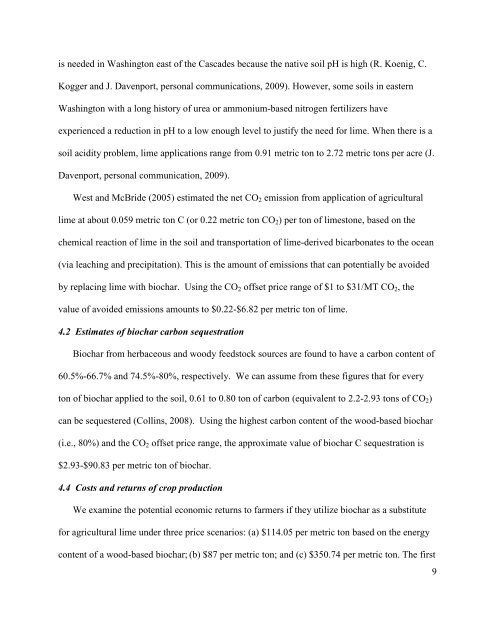is needed <strong>in</strong> Wash<strong>in</strong>gton east <strong>of</strong> the Cascades because the native soil pH is high (R. Koenig, C.Kogger <strong>and</strong> J. Davenport, personal communications, 2009). However, some soils <strong>in</strong> easternWash<strong>in</strong>gton with a long history <strong>of</strong> urea or ammonium-based nitrogen fertilizers haveexperienced a reduction <strong>in</strong> pH to a low enough level to justify the need for lime. When there is asoil acidity problem, lime applications range from 0.91 metric ton to 2.72 metric tons per acre (J.Davenport, personal communication, 2009).West <strong>and</strong> McBride (2005) estimated the net CO 2 emission from application <strong>of</strong> agriculturallime at about 0.059 metric ton C (or 0.22 metric ton CO 2 ) per ton <strong>of</strong> limestone, based on thechemical reaction <strong>of</strong> lime <strong>in</strong> the soil <strong>and</strong> transportation <strong>of</strong> lime-derived bicarbonates to the ocean(via leach<strong>in</strong>g <strong>and</strong> precipitation). This is the amount <strong>of</strong> emissions that can potentially be avoidedby replac<strong>in</strong>g lime with biochar. Us<strong>in</strong>g the CO 2 <strong>of</strong>fset price range <strong>of</strong> $1 to $31/MT CO 2 , thevalue <strong>of</strong> avoided emissions amounts to $0.22-$6.82 per metric ton <strong>of</strong> lime.4.2 Estimates <strong>of</strong> biochar carbon sequestration<strong>Biochar</strong> from herbaceous <strong>and</strong> woody feedstock sources are found to have a carbon content <strong>of</strong>60.5%-66.7% <strong>and</strong> 74.5%-80%, respectively. We can assume from these figures that for everyton <strong>of</strong> biochar applied to the soil, 0.61 to 0.80 ton <strong>of</strong> carbon (equivalent to 2.2-2.93 tons <strong>of</strong> CO 2 )can be sequestered (Coll<strong>in</strong>s, 2008). Us<strong>in</strong>g the highest carbon content <strong>of</strong> the wood-based biochar(i.e., 80%) <strong>and</strong> the CO 2 <strong>of</strong>fset price range, the approximate value <strong>of</strong> biochar C sequestration is$2.93-$90.83 per metric ton <strong>of</strong> biochar.4.4 Costs <strong>and</strong> returns <strong>of</strong> crop productionWe exam<strong>in</strong>e the potential economic returns to farmers if they utilize biochar as a substitutefor agricultural lime under three price scenarios: (a) $114.05 per metric ton based on the energycontent <strong>of</strong> a wood-based biochar; (b) $87 per metric ton; <strong>and</strong> (c) $350.74 per metric ton. <strong>The</strong> first9
value represents the opportunity cost <strong>of</strong> the foregone use <strong>of</strong> biochar as energy source. A woodbasedbiochar has an average energy content <strong>of</strong> 12,500-12,500 BTU/lb (Dynamotive EnergySystems, 2007). <strong>The</strong> energy content <strong>of</strong> the Central Appalachian coal is 12,500 BTU/lb <strong>and</strong> itsprice is $116.38 per metric ton as <strong>of</strong> 2008 (EIA, 2009). Us<strong>in</strong>g the energy content as basis, thecombustion value <strong>of</strong> biochar is 98% that <strong>of</strong> Central Appalachian coal, or $114.05/metric ton. <strong>The</strong>latter two prices are adopted from the estimated break-even prices <strong>of</strong> biochar <strong>in</strong> Granatste<strong>in</strong> et al.(2009).Wheat, a key economic crop <strong>in</strong> Wash<strong>in</strong>gton, belongs to a group <strong>of</strong> crops that can tolerateslightly acidic (i.e., 6.0-6.5) soil pH (CPHA, 2002). In general, wheat tends to favor soil pHbetween 6 <strong>and</strong> 7 (Beegle <strong>and</strong> L<strong>in</strong>genfelter, 2005). We focus on changes <strong>in</strong> w<strong>in</strong>ter wheat yieldgiven changes <strong>in</strong> the soil pH as a case study. <strong>The</strong> crop yield is estimated through the follow<strong>in</strong>gequation adopted from Mahler (1986):W<strong>in</strong>ter Wheat Yield = −2,960.56 + 1,530 SOILPH (1)where w<strong>in</strong>ter wheat yield is <strong>in</strong> kilograms per hectare, <strong>and</strong> SOILPH refers to the value <strong>of</strong> the soilpH <strong>of</strong> Palouse silt loam. Assum<strong>in</strong>g the base soil pH <strong>of</strong> 4.5 for this soil type from Coll<strong>in</strong>s (2008),<strong>in</strong>creas<strong>in</strong>g the soil pH to 6 would require 2.59 metric tons <strong>of</strong> limestone per acre (CPHA, 2002) or30.62 metric tons <strong>of</strong> biochar per acre (H. Coll<strong>in</strong>s, unpublished data). 5Us<strong>in</strong>g equation (1) with soil pH <strong>of</strong> 4.5, wheat yield is estimated at about 3,924.44 kg perhectare or 58.36 bushels per acre. 6On the other h<strong>and</strong>, with a soil pH <strong>of</strong> 6, the estimated wheat5 Note that the impact <strong>of</strong> char on soil pH depends on the soil type <strong>and</strong> the type <strong>of</strong> char. For the Palouse silt loamsoil type, an average pH <strong>in</strong>crease across the chars is ~0.049 pH unit/ ton <strong>of</strong> biochar per acre. Based on this, it wouldrequire about 30.62 tons/acre to <strong>in</strong>crease the soil pH from 4.5 to 6 (i.e., <strong>in</strong>crease by 1.5 units).6 Conversion: 1 bushel per acre x 0.06725 = 1 metric ton (or 1,000 kg) per hectare (Prairie Gra<strong>in</strong>s Magaz<strong>in</strong>e,2003).10
- Page 4 and 5: productivity, and some examine bioc
- Page 6 and 7: soil nutrients as a consequence of
- Page 8 and 9: Incentives for greenhouse gas mitig
- Page 12 and 13: yield is about 6,219.44 kg per hect
- Page 14 and 15: iochar is about $95.75/MT. On the o
- Page 16 and 17: ReferencesAzargohar, R., Dalai, A.
- Page 18 and 19: Gaunt, J.L., Lehmann, J., 2008. Ene
- Page 20 and 21: Steiner, C., Teixeira, W.G., Lehman
- Page 22 and 23: Table 1 (continued)Summary of studi
- Page 24 and 25: Table 3Comparison of profits from w
- Page 26: AppendixAssumptions used to calcula
















